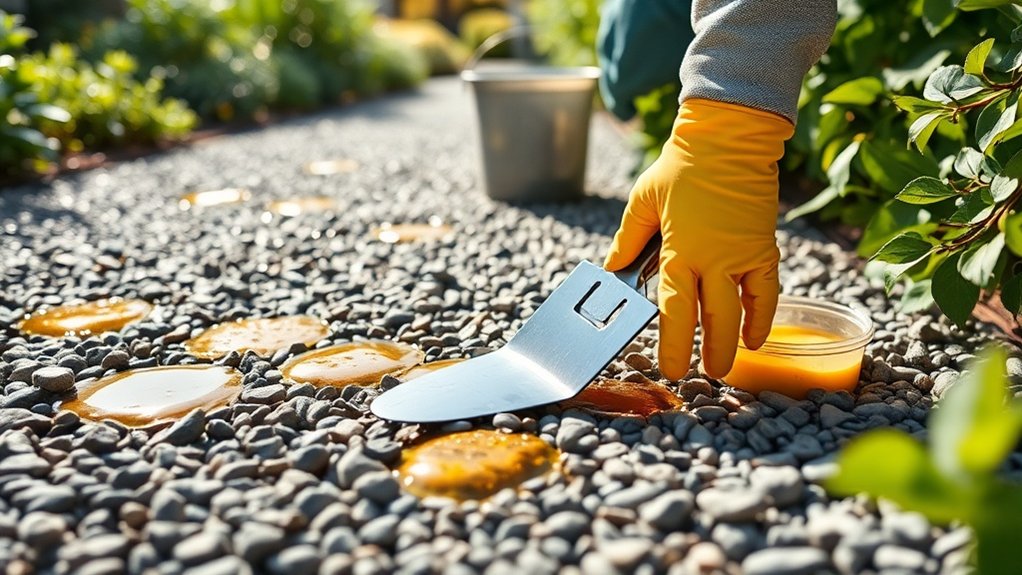To fix resin-bound gravel that has pooled water, first check for debris and cracks that could hinder drainage. Make sure the sub-base is properly compacted and slopes away from buildings to encourage runoff. Assess the resin’s UV stability and density to ensure adequate drainage. You might need to install extra drains or adjust the mix of aggregate and resin. Regular maintenance is key to preventing future pooling. For more practical solutions, keep exploring the necessary steps.
Key Takeaways
- Check the surface for debris or blockages that could impede drainage and remove them straight away.
- Ensure the base is properly graded to direct water runoff away from areas where it tends to pool.
- Inspect the sub-base for any compaction issues and repair any weak spots or cracks to improve drainage.
- Maintain drainage systems by ensuring they are clear, correctly aligned, and sloped towards outlets to avoid water build-up.
- Reseal the resin-bound surface every 1-2 years to protect it and enhance permeability for better water management.
Identifying the Causes of Water Pooling
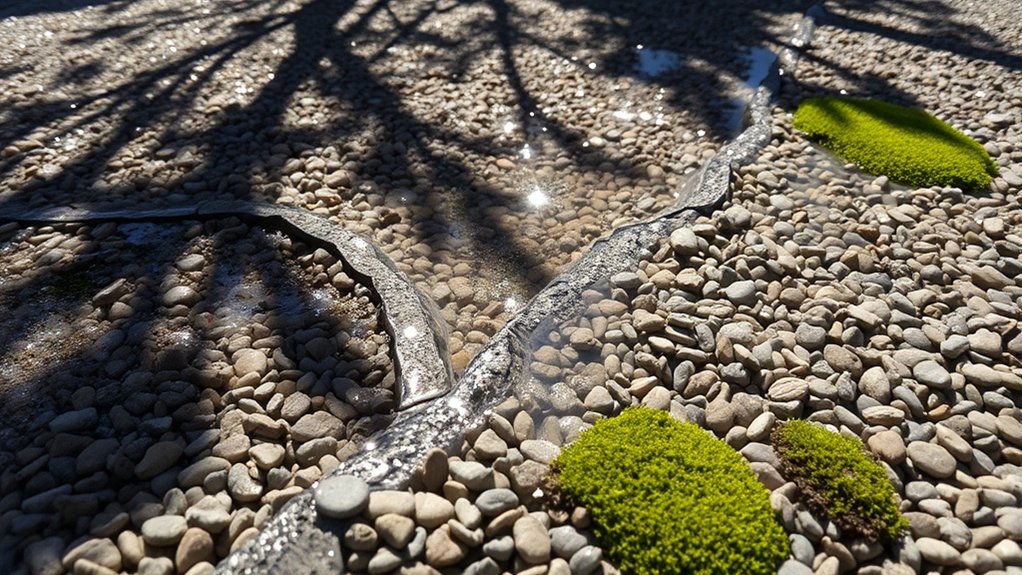
When you see water pooling in your resin-bound gravel, it’s important to identify the causes to resolve the issue effectively.
First, check if the gravel is laid over a non-permeable base, such as concrete, which can impede proper drainage. Ensure that your base is graded correctly with a gentle slope to encourage water runoff.
If the resin isn’t UV-stable or is too dense, it may trap water on the surface, worsening the pooling. Additionally, improper installation can lead to drainage issues, exacerbating the problem. This is particularly true if trapped moisture is present between layers, which can further contribute to the issue.
Also, look for debris that might be blocking the porous surface, as this can prevent water from draining away.
Finally, assess your drainage solutions, like gutters and downspouts, to make sure they’re directing water away from the gravel surface to avoid accumulation.
Assessing the Current Condition of Your Resin-Bound Gravel
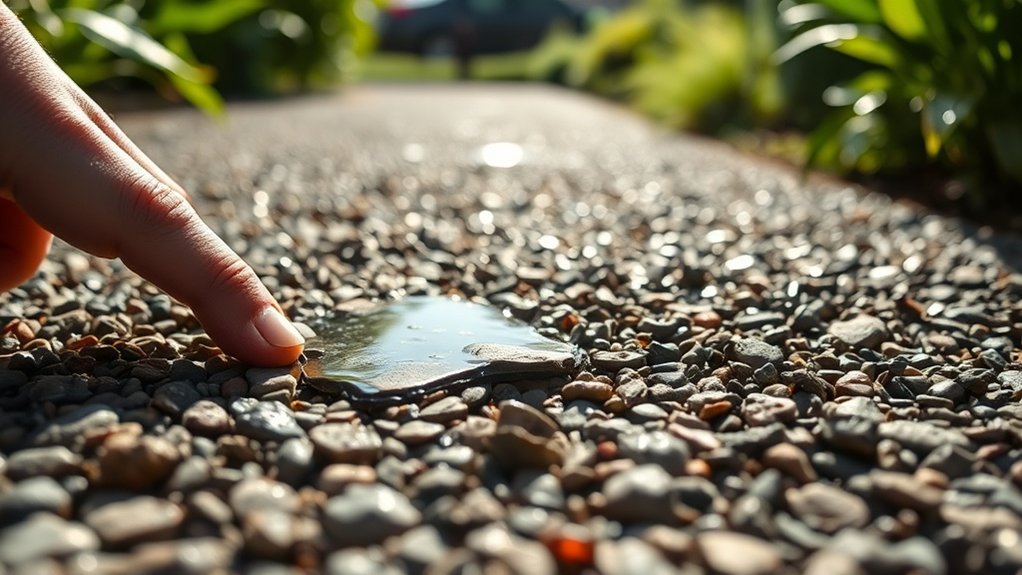
To tackle water pooling issues effectively, it’s essential to assess the current state of your resin-bound gravel. Start with a detailed surface inspection for visible damage such as cracks or uneven patches. Check the resin for brittleness or loss of flexibility, as this can affect drainage. Note any discolouration, which could indicate areas where water is being retained. The following table can help guide your assessment:
| Evaluation Area | Key Indicators | Action Required |
|---|---|---|
| Surface Condition | Cracks, holes, uneven texture | Repair or resurface |
| Drainage Assessment | Blocked channels, pooling areas | Remove obstructions |
| Resin Integrity | Brittleness, peeling | Replace or repair resin |
| Environmental Factors | UV damage, chemical spills | Resolve external issues |
| Installation Quality | Adherence to best practices | Verify proper installation |
Additionally, ensure that the surface meets the recommended thickness of 15-20mm for vehicle traffic, as this plays a crucial role in effective drainage. Regular inspections to catch early signs of wear are vital for maintaining the integrity of your resin-bound surface.
Inspecting the Sub-Base for Issues
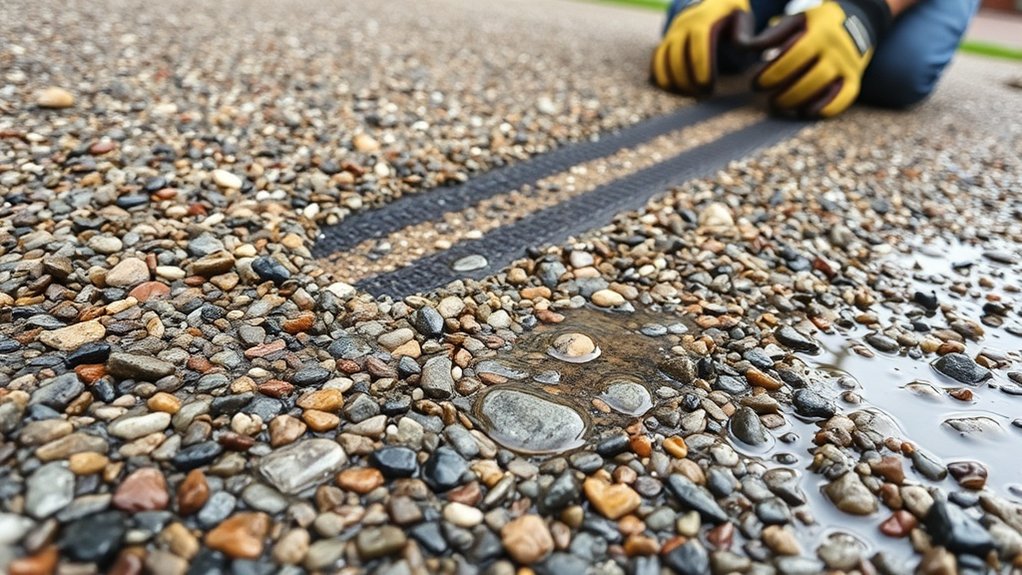
Inspecting the sub-base for issues is vital, as it directly affects the performance and lifespan of your resin-bound gravel surface.
Begin with a detailed inspection to spot weak areas, cracks, or poorly compacted sections that might lead to water pooling later on. Employ effective compaction methods, such as vibration or plate compactors, to ensure a solid foundation and prevent subsidence. Make sure your sub-base material is suitable—ideally non-frost susceptible MOT Type 3 aggregate—allowing for proper drainage and free from loose debris. The sub-base must also be designed to increase strength and provide a working platform, which is crucial for optimal performance. Additionally, ensure that the thickness of the sub-base matches the expected usage to provide adequate support and prevent premature wear. Check for even compaction levels across the area; inconsistencies can lead to localised settlement.
Evaluating Surface Slope and Leveling
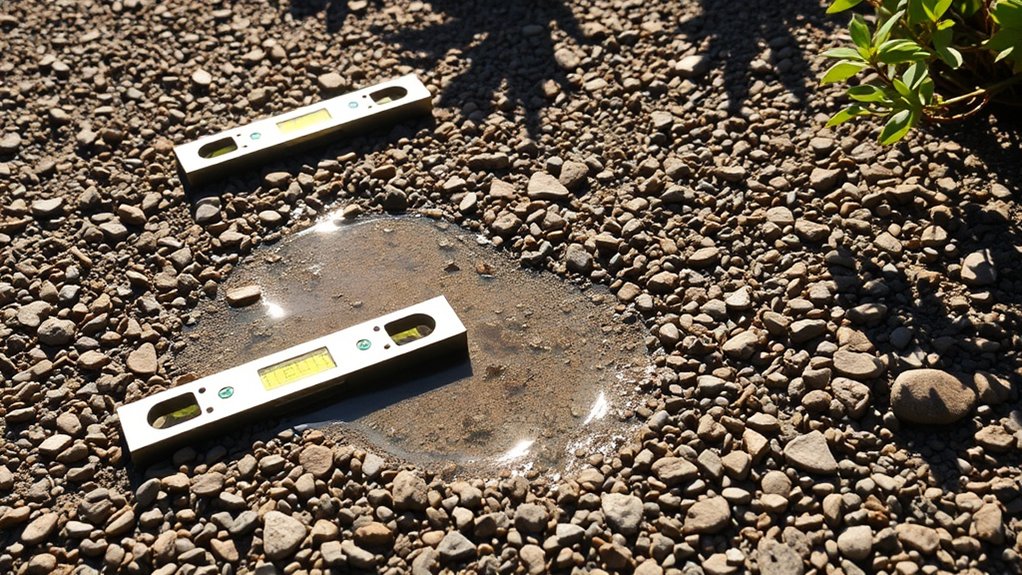
Evaluating surface slope and ensuring proper levelling are crucial for effective drainage and preventing water pooling in resin-bound gravel installations.
Start by assessing the slope, aiming for a gradient of around 1:60 to promote water runoff. Gentle slopes, ideally up to 5%, are best, as steeper gradients can cause resin runoff and uneven application.
Ensure the slope directs water away from buildings to avoid localised flooding.
To address pooling areas, employ techniques like grinding or scarifying.
Using precision screeding and trowelling during installation helps achieve an even surface.
Always check for level with laser or water levels before applying resin to prevent future pooling and ensure optimal drainage.
Analyzing Aggregate-Resin Mix Ratios
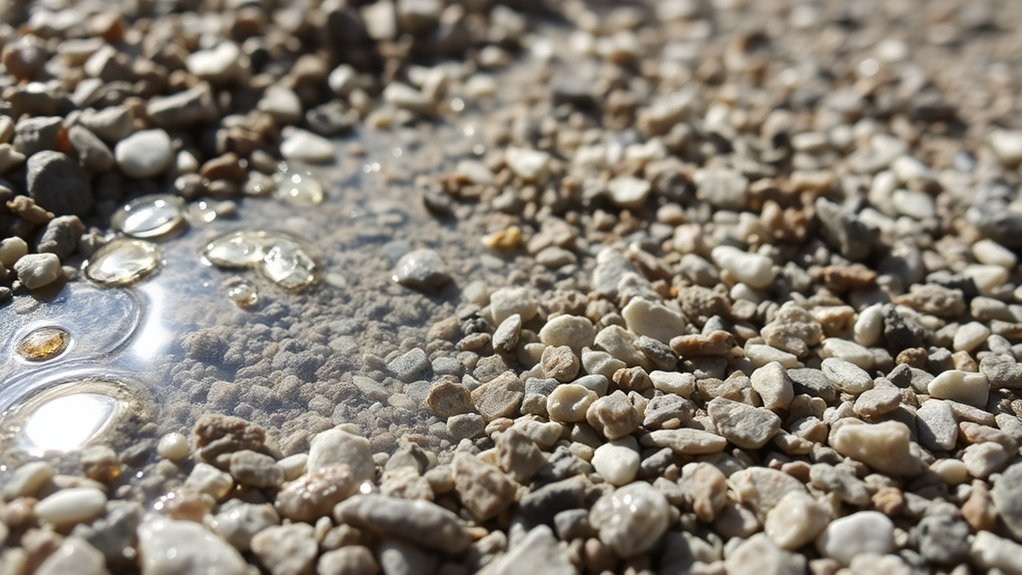
When analysing aggregate-resin mix ratios, it’s crucial to find the right balance between resin concentration and aggregate types to ensure a durable surface. A resin concentration of 6% to 8% typically provides optimal water resistance and durability.
For strength, use a mix of 75% 2-5mm aggregates and 25% 1-3mm aggregates. You might also consider adding binding agents like quartz to improve load-bearing capacity and aesthetics.
Ensure precise mixing techniques to achieve an even distribution and prevent colour variations. Consistent mixing time is key to maintaining quality.
Additionally, regular maintenance will enhance the surface’s longevity, keeping it functional and visually appealing over time.
Checking Drainage Systems and Channels
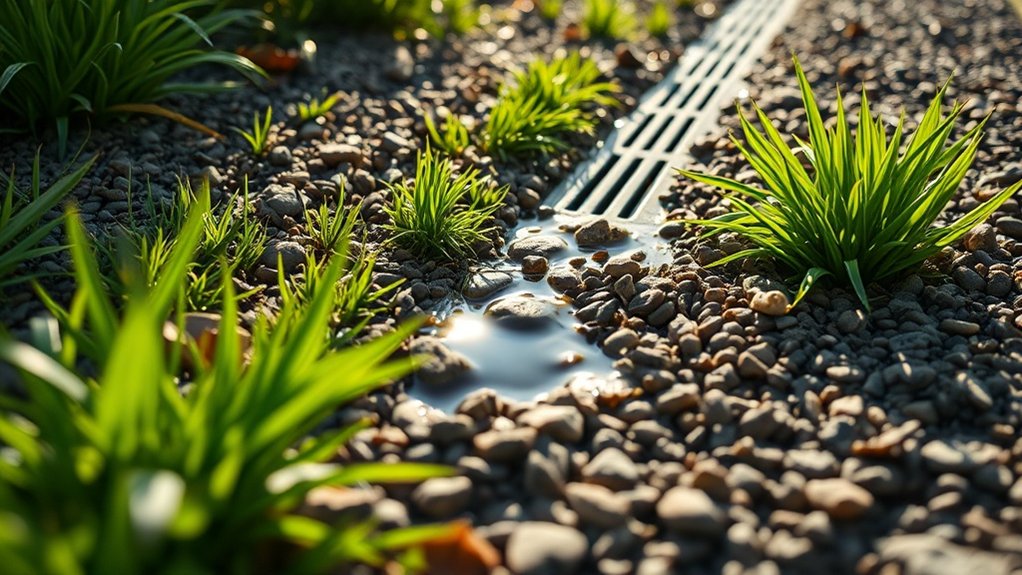
To ensure effective drainage and prevent water pooling in resin-bound gravel surfaces, it’s crucial to check the integrity of drainage systems and channels.
Start with a thorough inspection to identify any blocked or misaligned channel drains that could disrupt water flow. Check grates for damage or missing sections that may lead to debris build-up.
Assess the gradient of the drains; they should slope towards the outlet to avoid ponding. Ensure the sub-base is permeable, as non-permeable bases can worsen pooling problems.
Regularly maintain soakaways and outfalls to prevent blockages from roots or sediment. Lastly, confirm that channel drains are correctly installed, aligned, and sized to handle the expected water volume for optimal performance over time.
Immediate Steps to Remove Pooled Water
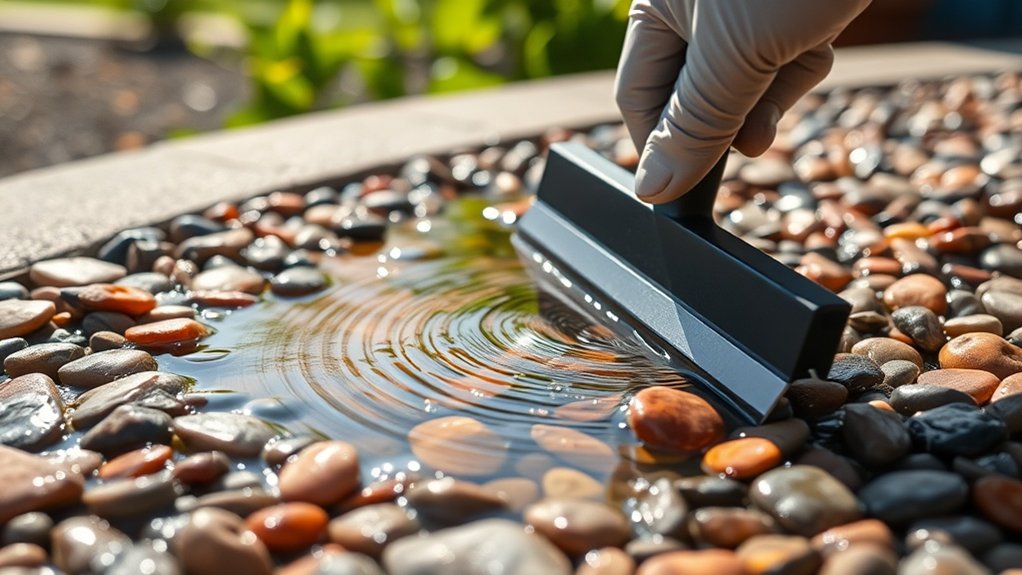
To remove pooled water from resin-bound gravel, act quickly to prevent damage and ensure proper drainage.
Start by using a garden hose on a moderate setting to gently rinse the surface. For larger amounts of water, a wet/dry vacuum or a water pump is your best bet for quick removal.
After removing the bulk of the water, use absorbent materials like sponges or microfiber cloths to soak up any remaining moisture. A squeegee or rubber-edged broom can help push the last bits of water towards drainage points.
Once the water is cleared, sweep away any debris and clean the surface with a mild, pH-neutral detergent mixed with warm water.
Gently scrub any stained areas and let the solution sit for 5-10 minutes before rinsing to remove any detergent residue.
Techniques for Re-Troweling or Relaying the Surface
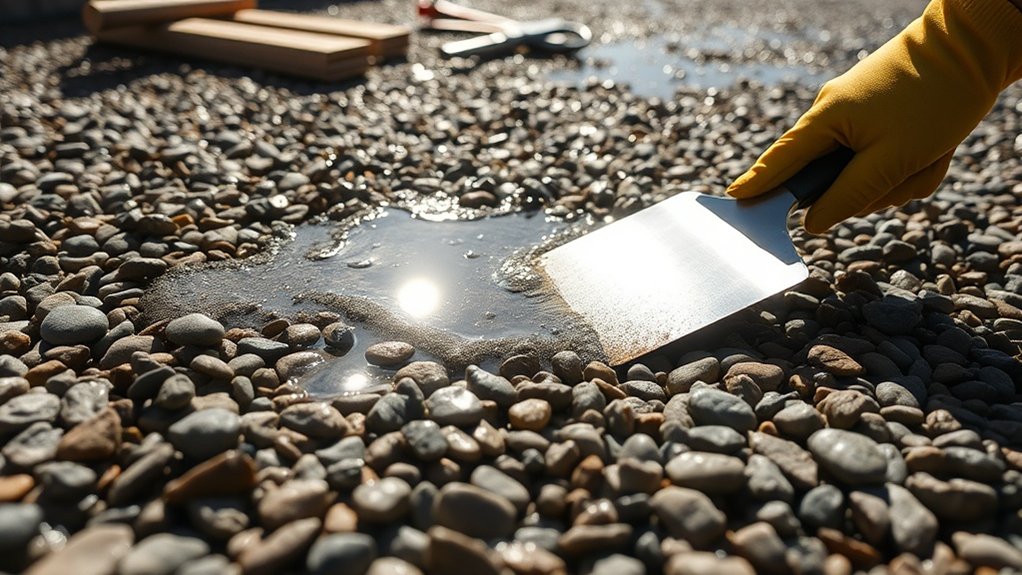
Once you’ve resolved the pooling issues, you can start re-trowelling or relaying the resin-bound gravel surface.
Proper surface preparation is essential for ensuring good adhesion of your resin. Here are three crucial techniques to follow:
- Clean Thoroughly: Clear away any debris and loose aggregates to create a stable base for the new layer.
- Mix Properly: Use a forced action mixer to blend the resin components evenly, then mix with clean aggregate to ensure consistency.
- Apply Evenly: Pour the resin-bound mixture into manageable sections, spreading it to a thickness of 30-40mm while maintaining a wet edge for a seamless finish.
Installing Additional Drains or Channels
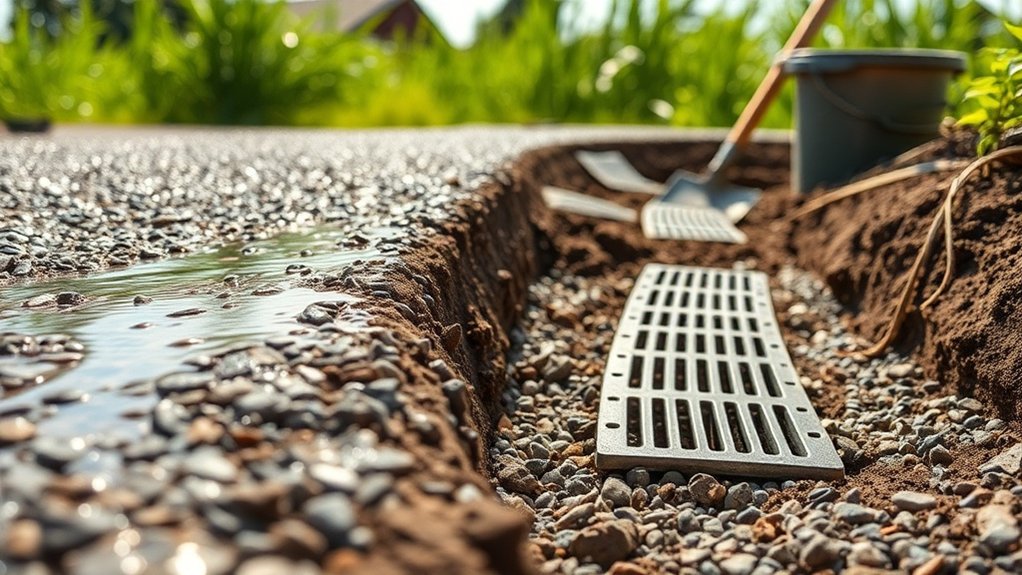
When dealing with persistent pooling in your resin-bound gravel, installing additional drains or channels is essential for effective water management.
Start by assessing your drainage layout; pinpoint low spots where water gathers and evaluate the surface area and slope to establish drainage requirements.
For installation, dig trenches at a gradient of 1-2% to guide water towards drains or soakaways. Depending on your situation, select suitable drain types, like linear channel drains or French drains.
Ensure proper integration with the resin layer by sealing edges and ensuring waterproof joints.
Regular maintenance is crucial; keep an eye on drains for blockages and clear any debris to maintain the efficiency and longevity of your drainage system.
Choosing the Right Sub-Base Materials
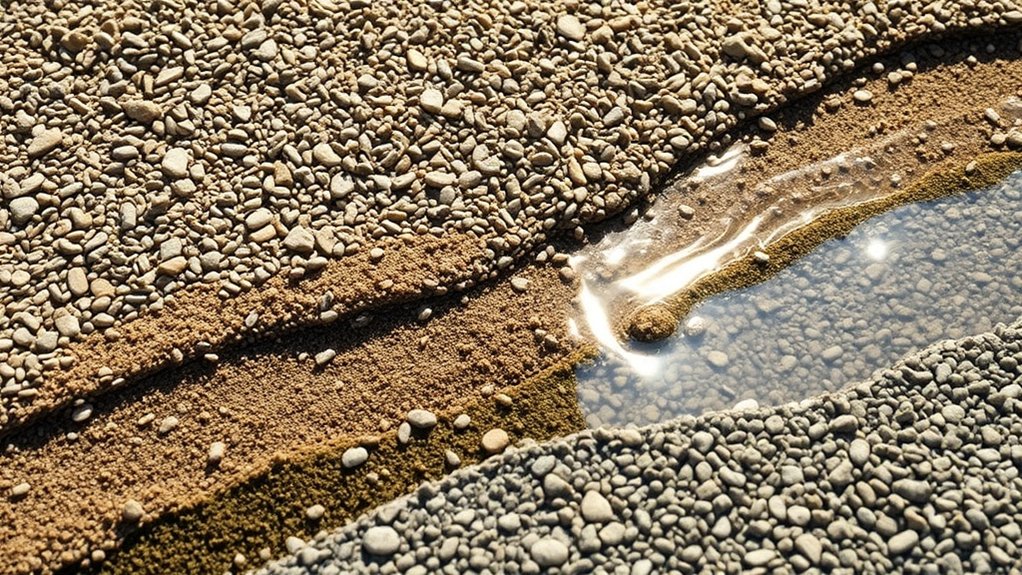
When selecting sub-base materials for resin-bound gravel, focus on permeability to improve water drainage and minimise pooling.
Suitable aggregates like MOT Type 3 and Type 1 offer the stability and load-bearing capacity needed while adhering to SuDS (Sustainable Drainage Systems) guidelines.
Employing proper grading techniques ensures a level surface that promotes effective drainage and enhances long-term performance.
Importance of Permeable Materials
Choosing the right sub-base materials is vital for ensuring the effectiveness of resin-bound gravel installations, as a permeable sub-base significantly influences drainage and surface performance.
To optimise permeability and drainage, keep the following points in mind:
- Material Choice: Opt for non-frost susceptible materials such as MOT type 3 crushed stone. This helps reduce water retention and maintains structural stability.
- Thickness: Ensure the sub-base thickness is between 100-250mm, depending on soil conditions, to achieve the best strength and drainage.
- Compaction: Properly compacted materials create a level surface that prevents water pooling and provides a solid foundation for the resin-bound surface.
Ideal Aggregate Types
Choosing the right aggregate types for your resin-bound gravel installation is crucial for optimal performance and longevity. Here’s a brief guide on common aggregate options:
| Aggregate Type | Key Features | Eco-Friendly Options |
|---|---|---|
| Compacted Type 1 | Load-bearing, porous, cost-effective | Yes, allows water drainage |
| Permeable Aggregate | Facilitates water flow, reduces pooling | Yes, SuDS compliant |
| Macadam and Concrete | Very durable, needs curing, non-permeable | Concrete needs extra drainage |
When selecting aggregates, focus on durability and consider eco-friendly options like recycled materials to boost sustainability. Well-chosen aggregates not only enhance stability and appearance but also support effective water management in your resin-bound system.
Proper Grading Techniques
Proper grading techniques are essential for creating a stable foundation for your resin-bound gravel installation, as they directly affect drainage and the lifespan of the surface.
Choosing the right sub-base materials plays a crucial role in ensuring stability and effective drainage. Here are three key points to consider:
- Material Choice: Opt for non-frost susceptible materials, such as MOT Type 3, which offer durability and protection against frost damage.
- Compaction: Ensure your sub-base is properly compacted to prevent movement under load and maintain a solid foundation.
- Drainage Design: Incorporate drainage channels or soakaways to manage water flow, avoiding pooling and potential surface damage.
Implementing Preventative Maintenance Practices
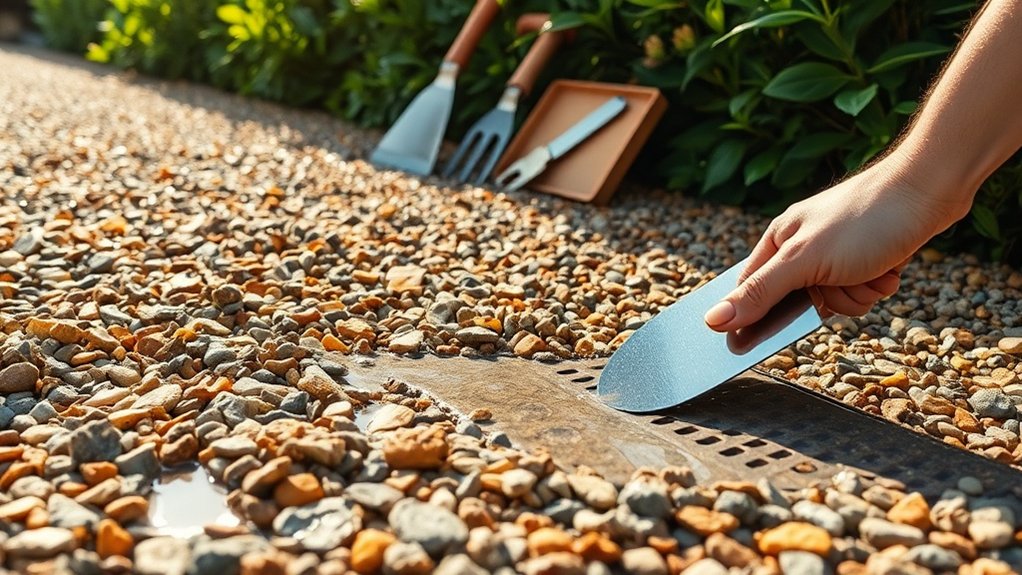
To ensure the longevity and performance of your resin-bound gravel surface, it’s crucial to adopt effective preventative maintenance practices.
Begin with regular inspections to identify any cracks, pooling water, or substrate issues. Sweep the surface routinely with a stiff broom or a non-metallic leaf blower to keep debris at bay.
Promptly tackle any weeds, making sure to remove the roots to stop them from regrowing. Clean up spills immediately using cornstarch or warm soapy water to prevent staining.
During seasonal changes, clear away leaves thoroughly and avoid using boiling water for ice removal. Reseal your surface every 1-2 years to guard against damage.
Understanding Environmental and Regulatory Compliance
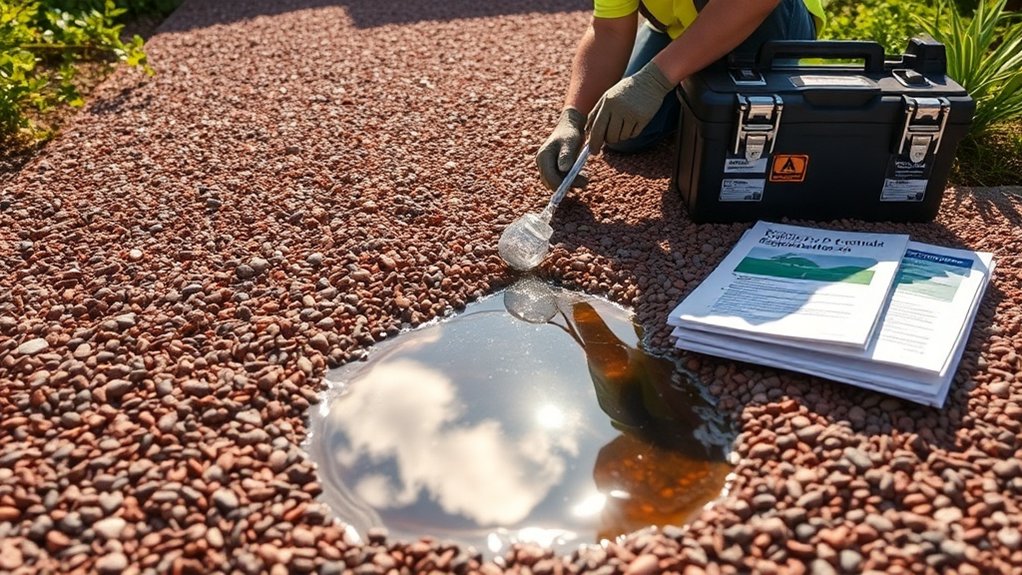
Understanding environmental and regulatory compliance is crucial when installing resin-bound gravel surfaces, as it ensures adherence to Sustainable Urban Drainage System (SUDS) regulations.
Compliance with SUDS not only meets legal requirements but also promotes environmental sustainability. Here are three key points to consider:
- Permeability Requirements: Ensure your gravel surface is permeable, allowing water to drain efficiently and reducing the risk of flooding.
- Local Authority Regulations: Check with your local planning authority to ensure you comply with environmental regulations and avoid enforcement actions.
- Material Standards: Only use SUDS-compliant resin-bound systems and follow correct installation methods to ensure long-term permeability.
Frequently Asked Questions
Can I DIY Repairs for Pooled Water Issues in Resin-Bound Gravel?
Yes, you can tackle pooling issues in resin-bound gravel yourself. Start by cleaning the affected area thoroughly. Next, apply suitable repair materials such as resin and aggregate. Don’t forget to adjust the slope of the surface to promote better drainage. This will help ensure effective repairs and reduce the risk of future problems.
How Long Does It Take to Fix Water Pooling Problems?
Most water drainage repairs typically take 1 to 2 days to complete. However, the duration can vary based on the severity of the issue and the method used for repairs. For example, addressing minor pooling may be quicker than tackling extensive drainage problems. It’s important to assess site conditions beforehand to ensure a smooth process.
Will Resin-Bound Gravel Crack if Water Pools Frequently?
Frequent water pooling can weaken resin-bound gravel, increasing the likelihood of cracks. Proper drainage is crucial; without it, the surface can deteriorate over time, leading to defects and structural problems. For example, if a driveway regularly collects water, it may not hold up as well, resulting in costly repairs down the line.
What Are the Costs Associated With Professional Repairs?
Repair costs for professional services on resin-bound gravel typically range from £80 to £120 per square metre. If you’re facing more complex issues, such as drainage problems, costs can rise significantly, especially for larger areas that need extensive preparation and high-quality materials. For example, if a section of your driveway requires special drainage solutions, you might end up paying considerably more than the standard rate.
Can Weather Conditions Affect the Installation of Resin-Bound Gravel?
Yes, weather conditions play a significant role in the installation of resin-bound gravel. The ideal temperature for installation is between 5°C and 25°C. It’s also crucial to keep an eye on moisture levels; high humidity can delay curing, which affects the durability and adhesion of the surface. For instance, if it’s raining or too damp, it’s best to postpone the work to ensure the best results.
Conclusion
To tackle pooled water in your resin-bound gravel, it’s important to understand the causes and take proper action. Start by checking for any blockages in drainage channels or falls that could be preventing water from flowing away. Regular maintenance, such as clearing debris and ensuring the surface is level, will help keep your gravel in good condition. For example, if you notice puddles forming, it might be worth adding a slight slope to encourage drainage. By staying on top of these issues, you can improve the look and longevity of your outdoor space. A little effort now can save you larger problems later.
